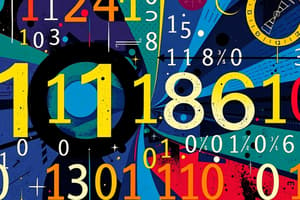Podcast
Questions and Answers
What is the base of the Decimal number system?
What is the base of the Decimal number system?
- 16
- 10 (correct)
- 2
- 8
In a binary number system, the digits used are 0 and 1.
In a binary number system, the digits used are 0 and 1.
True (A)
What is a nybble?
What is a nybble?
4 bits
What is the highest digit used in the hexadecimal number system?
What is the highest digit used in the hexadecimal number system?
A byte consists of ______ bits.
A byte consists of ______ bits.
What is the two's complement of the binary number 01010100100?
What is the two's complement of the binary number 01010100100?
1K (kilo or ‘kibi’) = ______
1K (kilo or ‘kibi’) = ______
Which number system uses the digits 0-9 and A-F?
Which number system uses the digits 0-9 and A-F?
In the binary number system, digit b0 is the most significant bit (MSB).
In the binary number system, digit b0 is the most significant bit (MSB).
What is the value of 4 + 8 in hexadecimal?
What is the value of 4 + 8 in hexadecimal?
Flashcards are hidden until you start studying
Study Notes
Base-N Number System
- Base N represents a number system with N unique digits.
- Digits range from 0 to N - 1.
- Positional number system assigns a value to each digit based on its position.
- The digit at the rightmost position is the Least Significant Digit (LSD) and the digit at the leftmost position is the Most Significant Digit (MSD).
Decimal Number System
- Uses base 10 with ten digits: 0, 1, 2, 3, 4, 5, 6, 7, 8, 9.
- Also a positional number system.
Binary Number System
- Uses base 2 with two digits: 0, 1.
- Binary digits are called bits.
- The rightmost bit is the Least Significant Bit (LSB) and the leftmost bit is the Most Significant Bit (MSB).
Definitions
- Nybble: 4 bits
- Byte: 8 bits
- Short word: 2 bytes (16 bits)
- Double word: 4 bytes (32 bits)
- Long word: 8 bytes (64 bits)
- 1k (kilo): 1,024
- 1M (mega): 1,048,576
- 1G (giga): 1,073,741,824
Hexadecimal Number System
- Uses base 16 with sixteen digits: 0, 1, 2, 3, 4, 5, 6, 7, 8, 9, A, B, C, D, E, F.
- Also a positional number system.
Binary Addition
- The single bit addition table guides addition with a carry if the sum is 2 or more.
Hex Addition
- 4-bit addition is used with carry when the sum exceeds F.
Hex Digit Addition Table
- Summarizes all possible hex digit additions, including carryovers for sums exceeding F.
1’s Complements
- Calculated by inverting each bit (0 becomes 1, 1 becomes 0).
2’s Complements
- Calculated by first taking the 1’s complement and then adding 1.
Complements
- The 2’s complement of the 2’s complement of a number results in the original number.
Two's Complement Representation for Signed Numbers
- Two’s complement notation is used to represent negative numbers.
- Two’s complement encoding is done by taking the 2’s complement of the positive value.
Studying That Suits You
Use AI to generate personalized quizzes and flashcards to suit your learning preferences.




